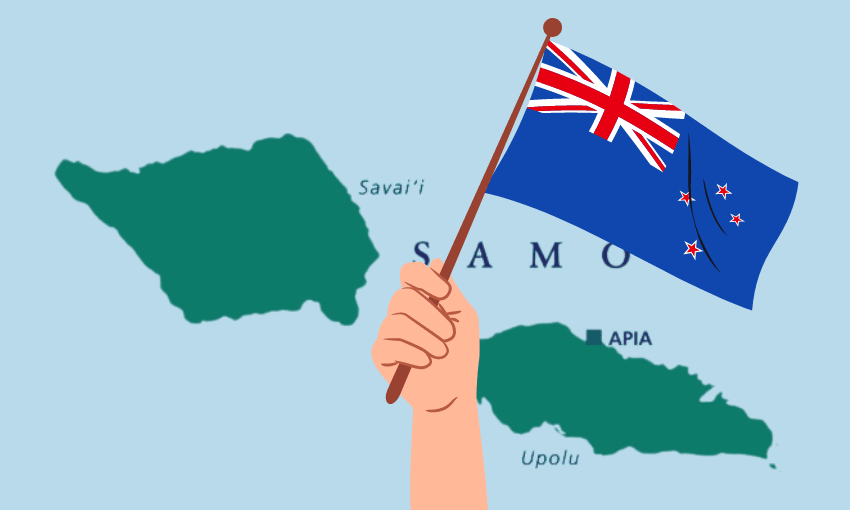The environmental impacts of a ‘highly probable’ oil spill is just the latest in a long relationship of New Zealand causing harm to Samoa.
On Saturday night, New Zealand navy survey ship HMNZS Manawanui capsized after running aground off the coast of Samoa. The cause of the sinking is now under investigation through a court of inquiry, but officials have expressed relief that all crew members were able to be safely rescued. Questions will soon turn to the clean up, with defence minister Judith Collins saying the government is focussed on the environmental impact.
Locals in Samoa would be forgiven for taking this pledge with a grain of salt given the way New Zealand has treated its Pacific neighbour in the past.
1893 – Here, have some measles
In 1893, the steamer Upolu left New Zealand, docked in Samoa and measles got off. It had come from Tonga and left measles there too. As a result, more than 1,000 Samoans died from the disease, of a population of 34,500 across five islands.
1914 – We’re in charge now
Samoa has long been a country fought over by western powerhouses. In the late 19th century, Germany, Britain and the United States tussled for power over the islands in what is known as two “civil wars” but was really a war between three outside countries, with Samoans doing the hard work of actually fighting. At the end of the second Samoan civil war (1899), the three countries came to an agreement: the eastern islands went to America and became American Samoa, Western Samoa became German Samoa, and Britain relinquished its rights to Samoa in exchange for the northern Solomon Islands.
During World War I, Britain suggested to New Zealand that taking control of German Samoa would be a “great and urgent Imperial service”. Eager to please, New Zealand did just that in 1914. The operation went off without a hitch and without opposition and suddenly New Zealand had an army administration in Samoa, effectively in control. It would soon become clear that New Zealand had no idea how to do that, though it retained control until Samoa gained independence in 1962.
1918 – Here, have some flu
Arguably the worst thing New Zealand (not the British when they arrived, but New Zealand itself since then) has ever done to Samoa is wiping out a quarter of the population in one fell swoop between 1918 and 1919.
On November 7, 1918, the New Zealand passenger and cargo ship Talune arrived at Apia from Auckland. The ship had left Auckland as the Spanish flu was spreading throughout the country. By the time it reached Fiji (before Samoa), several crew members were sick and the ship was quarantined.
But when it got to Apia, the captain and the port health officer discussed the sickness of those on board, did a cursory sweep of the ship and gave it a clean bill of health. Passengers (including those sick with the flu) were allowed to disembark. Within two months, 8,000 Samoans had died from the flu, with deceased loved ones gathered up and buried in mass graves. By the end of 1919, an estimated 8,500 people had died from the outbreak, 22% of the population of Western Samoa. A later inquiry found the New Zealand administration’s response severely lacking.
New Zealand was so despised as an overseer that petitions were drawn up asking for power to be handed to the United States.
1929 – Black Saturday
The discontent among Samoans at the ineptitude of New Zealand officials in handling the 1918 flu epidemic only grew over the coming years. The New Zealand military administration was heavy handed in its attempts to “modernise” Samoa, which presented as attempts to eliminate Samoan traditions and customs. In return, it was viewed as both inept and dishonest by the Samoan people. The Mau movement began before New Zealand took control but grew massively in prominence after the flu epidemic. Formed in Savai’i, the Mau was a non-violent protest movement with the aim of Samoan independence. The leaders of the Mau were relatively young chiefs, thrust into leadership after many older chiefs died of the flu. Their non-violent protests in the 1920s included boycotting imported goods and refusing to pay taxes, while villages ignored visiting officials or withdrew their children from government schools.
As the movement grew, New Zealand administrator George Richardson responded with force. In 1928, two New Zealand naval warships sailed to Samoa to assist in making arrests and maintaining order.
Then in the final week of 1929, a Mau parade was disrupted by police attempting to arrest the Mau secretary, who had been ordered not to participate. The marchers pushed back against police, who called for back-up. Tensions escalated and some police fired guns into the crowd before fleeing to the police station with the crowd in pursuit. One police officer was killed.
Once back at the police station, three police officers fired their rifles into the crowd, killing 11 people.
Following the shooting, the Mau movement was banned and members fled into the bush, pursued by NZ marines. The women of the Mau movement took up the cause and kept it alive until 1935 when a Labour government was elected in New Zealand and recognised the Mau movement as legitimate.
In 2002, then prime minister Helen Clark made a formal apology for the historic harm caused to Samoa by the New Zealand administration.
1950s – Come one, come all (labourers)
In the 1950s, New Zealand needed unskilled labourers, and turned to the Pacific Islands to fill the gap. Record migration occurred, with heavy incentives from New Zealand in the 50s and 60s, including overlooking a number of visa requirements for those coming here to work. In 1962, when Samoa officially gained independence, New Zealand and Samoa signed a “Treaty of Friendship” and the friendship was considered strong with a move to New Zealand a new dream for many Samoan families.
1970s – Leave one, leave all
During the economic downturn, New Zealanders suddenly weren’t keen on their new friends taking their jobs (read: doing the jobs they never wanted to do). The Labour government began dawn raids in 1974 – early morning raids on houses with suspected overstayers due to expired work visas. The vast majority of deportations at the time were Pacific people, despite making up only a third of overstayers.
In 2021, then prime minister Jacinda Ardern made a formal apology for the harm caused to the Pacific community by dawn raids.
1982 – Citizenship (Western Samoa) Act 1982
Western Samoa gained independence in 1962 but Samoans in New Zealand born in the few decades before that had no clarity on their legal status . In 1982, the Privy Council ruled that those born in Samoa between 1924 and 1948 were British subjects and therefore New Zealand citizens. The New Zealand government responded by rushing through the Citizenship (Western Sāmoa) Act 1982, which essentially overruled this. It has since been described as “New Zealand’s most racist immigration law“.
In 2024, a bill was introduced to parliament that would repeal the Citizenship (Western Sāmoa) Act 1982. It is currently before the select committee with a report due on October 10.
2019 – Here, have some measles (again)
In August 2019, it’s believed a passenger on a flight from Auckland to Apia reintroduced measles to the Samoan population. It quickly spread, with 3% of the population infected and 85 deaths, the vast majority of whom were children. Back in New Zealand, prominent cartoonists made bad jokes about the epidemic, seemingly ignorant of New Zealand’s role in the worst Samoan epidemics throughout history.
2024 – HMNZS Manawanui sinks
On Saturday, New Zealand navy survey ship the HMNZS Manawanui hit a reef off the south coast of Upolu and sank. Local fire and emergency services rescued the crew of the ship, with no casualties. While the New Zealand government has pledged to “work with Samoa” on the clean-up, it’s not yet known what the effect of the “highly probable” oil spill and sunken vessel will have on the local businesses and environment. Locals have reported a strong smell of oil in the lagoon area, where many find their food and bathe.
Prediction: A formal apology from a Labour prime minister in 2054 for the damage this incident will do to Samoa’s environment, in the spirit of friendship.

